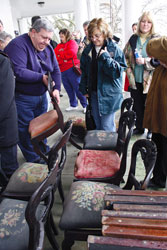Photos by Angela Shoemaker
It’s 10 a.m. on a brisk February Saturday and auctioneers Ken Hays and his associates are in full swing, selling to the highest bidders the contents of a 100-year-old Mockingbird Valley estate high on the bluffs above the Ohio River.
Some 300 people are gathered in and around the stately, slightly decaying 5,300-square-foot Colonial Revival home. Ads for the auction had touted the riches of goods in the home: sterling, art glass, furniture, all in the name brands of the antique world. The house itself and the 10-acre estate around it will be up for bid later in the day. Hays has nearly 20 staff members along to handle the bidders.
All eyes are on Hays & Associates auctioneer Gary Campbell and the old lamp he’s offering.
Bidder Leo Schwendau, a resident of Old Louisville, is on the second floor, standing near one of two auction rings; the other is on the first floor. He’s got his eye on a child’s oak rocker attributed to noted Craftsman furniture maker and architect Gustav Stickley, dating from about 1910. Schwendau has a definite advantage: He is tall, towering above most of his competitors. On the second floor, where the action is brisk but the rooms are small, height and patience are the bidder’s best friends. 
The veteran bidder persists and gets the chair, which he says will be a gift to his sister, and heads downstairs to perhaps bid on a Roycroft American Beauty vase that’s getting a lot of attention outside on the front porch.
Schwendau is in the midst of explaining his passion for collecting restaurant china when he stops, mid-sentence, to monitor the Roycroft action. He and a few other “maybe” bidders are quiet, still and intensely engrossed as they stand on the outside porch, watching active bidders duke it out for the sought-after vase.
His number clutched in one hand, his newly acquired rocker sitting at his feet, he looks for his chance to pounce. But the vase quickly passes the $700 he would have paid and is gaveled off at $1,700. A fri/files/storyimages/wanders up and commiserates with Schwendau about the lost chance as they admire the item.
Ann Hays assists son Ken Hays Jr. in putting timeworn books and documents on the auction block.
This is the world of estate auctions, where bidders vie for bargains and, for some, hope for that incredible find to add to a cherished collection. Estate auctions are the bulk of the business of auctioneers Ken and Ann Hays, antiques aficionados and, at one time, Antiques Roadshow experts who have parlayed their knowledge into a 35-year career. The Hayses were educators by trade when they became interested in auctions. Ken started the business; Ann joined him a few years later. Their son, Ken Hays Jr., also works with them.
The browsers and bidders at this auction include people who aren’t antiques experts but have a strongly specialized interest in perhaps one or two types of items. Some are indeed antiques dealers, but most are collectors with day jobs who att/files/storyimages/auctions as an avid hobby. They’re clock collectors with an eye on a particularly distinctive antique or collectible example. Or they want a specific kind of dish to round out their porcelain collection. They come knowing what they’re looking for, but sometimes leave with something they never intended to buy. All have this in common: They aren’t satisfied with what they find at gift shops and furniture stores. They’re drawn to unusual pieces that display aged character. The crowd does skew older, but includes a few under-40 faces.
The Hayses have auctioned off estates, as they’re doing today, but they’ve also held auctions of specialty collections, including in one instance a huge music box collection. For that auction, they had to research music boxes extensively so they could properly advertise the sale. “We spent longer preparing for that auction than any sale we’ve ever done,” Ken Hays says. “When you get something you are not familiar with, you have to become knowledgeable. We did a lot of intense research.”
Any Sleeping Beauties out there looking for a spinning wheel?
The largest auction? Items from the old 
For the uninitiated, estate auctions take a little explaining. It all starts when a family member or a trustee for an estate contacts an auction company, which then catalogs everything in the home, examining it for damage weeks or even months before the auction date, says Hays. He himself polishes silver, if needed, to have a close look at it for pattern and style and to make sure it isn’t scratched or otherwise damaged.
On the day of the sale, or sometimes a day or two ahead of it, a preview is held so those wanting to bid on items have an opportunity to closely examine anything they think they might want to bid on. They can check for damage or even research a piece to help them determine how high they’ll go. Most estate auctions are held on weekdays, Hays says, as bidders have a lot of projects competing for their time on weekends.
When bidders arrive at the auction site on the day of the sale, they sign up, giving their name, address and other contact information and sometimes even have to show photo identification to get a number for bidding. The numbers are printed on white cards, and bidders hold their numbers aloft when they want to buy something. The auction company records which numbers won which items and the finishing price, and bidders pay for everything at once when they leave for the day. The Hayses even tape the auctions, giving them records of finishing bids to supplement the handwritten records kept by staff.
Auctions bring together collectors who may only see one another on auction days. John Connelly, proprietor of J.C. Dreamlight, an antique store in Old Louisville that sells
Connelly’s competing, in a friendly way, with Schwendau for a few select pieces, including the Stickley chair that Schwendau won. He also had his eye on the Roycroft piece but, like Schwendau, wasn’t willing to pay $1,700 for it. Knowing your limits is essential at auctions, Connelly says, as is recognizing what’s a real antique and what’s not. “Try to do your homework before so you don’t sp/files/storyimages/$500 on a $20 piece of pottery,” Connelly advises. “Two people who don’t know what they’re doing, bidding against each other, can make a serious mistake. Don’t assume just because the lady was 90 years old when she died that everything in the house was 90 years old. She could have gone shopping when she was 85.”
But that was not the case with the late Anne Stuart Duncan, whose home and contents are up for sale today. It appears
This house was built in 1904 by noted architect Arthur Loomis, who also designed the
Some bidders are curious about whether or not the house will sell when it is put up for auction at 1 p.m. Ken Hays Sr. stands on the home’s grand staircase and leads the auctioning of the house at a snail’s pace compared to the rapid-fire clip he’s kept up the rest of the day. It does not sell. There are bids, but none hit what’s called the reserve, which is the price that bidding has to reach for a sale to be made.
This crowd seems to want what it can carry — box lots, small furniture. A nice but large old couch sells for about $10, probably because no one else would bother with something so awkward. Connelly comments that such items are often the best buys at estate auctions, as are utilitarian pieces like appliances.
As the day goes on, bidders duck into the kitchen for a quick hot dog and soda and continue to follow the action. With so many people in attendance, it’s noisy and busy, and every 30 seconds or so the auctioneer, Ken Hays Jr., working what was once the parlor, tells the audience to quiet down. They do, for a few seconds, but then they’re right back at it. They talk, eat, examine merchandise, exchange gossip and watch as the items are snapped up, one by one. The auctioneer tries again and again to get the crowd to simmer down, with little luck.
Crowds ebb and flow at estate auctions. Connelly notes that bargains can sometimes be found at the /files/storyimages/of the day because not many people have the patience to stay until the end.
Bidders are indeed lured to auctions by the promise of a great antique at a bargain price for their own collections, Hays says. But some also see entertainment, and a possible profit, in it. Harry and Sherry Jacobsen-Beyer, residents of Old Louisville, attended auctions decades ago, and in the past two or three years picked up the habit again. They like box lots, and buy them frequently to break up and list on eBay. They keep what they like of it. “I love to watch two people go head-to-head and try to guess who’s going to get it,” Harry Jacobsen-Beyer says. “It’s amazing to watch that.”
The Jacobsen-Beyers will buy a box of records, 45s, on this day and int/files/storyimages/to resell them on eBay, hopefully pocketing a nice profit. They aim for auctions at the actual home of the estate, thinking they’ll find better items. They especially look for auctions in wealthier neighborhoods that are likely to have higher-quality antiques.
Connelly says he’s a bit concerned about the future of estate auctions. He wonders if the next generation is as interested in collecting as their parents. He may be on to something. At the
But Hays notes that the generation using eBay to sell items worldwide has to get their items from somewhere. And the multitude of decorating shows populating cable television today often tout the idea of using thrift store or auction finds and a little elbow grease to create a unique look for the home.
For the auction-goers who are seeking unusual, historically significant, nostalgia-inducing furniture or collectibles to add to their daily lives, there just isn’t any substitute for actually handling the merchandise, and no better thrill than being that winning bidder, in person, who gets handed the spoils of their day toiling at the auction. “It’s the challenge of the auction that’s the appeal,” Hays says. “They are not competing against each other so much as the marketplace.”


